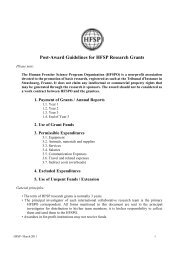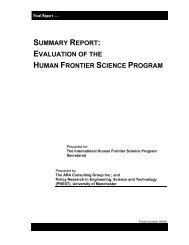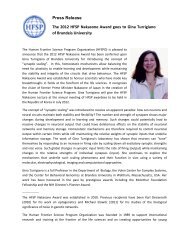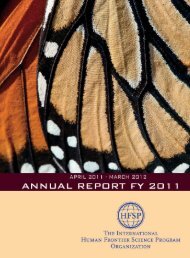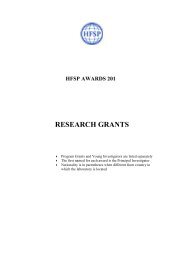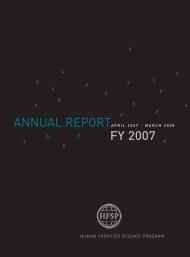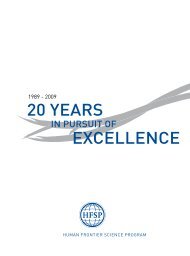Annual Report Fiscal Year 2001/2002 - Human Frontier Science ...
Annual Report Fiscal Year 2001/2002 - Human Frontier Science ...
Annual Report Fiscal Year 2001/2002 - Human Frontier Science ...
Create successful ePaper yourself
Turn your PDF publications into a flip-book with our unique Google optimized e-Paper software.
Annex 7<br />
62<br />
—<br />
<strong>Annual</strong> <strong>Report</strong> for FY <strong>2001</strong><br />
The HIV virus uses these proteins to recognize and bind to T-cells of<br />
the human immune system; and these proteins present perhaps<br />
the best target for AIDS vaccines. Nevertheless, Hendrickson’s studies<br />
of these proteins elucidated a variety of cunning tactics the HIV virus<br />
has evolved to evade antibodies and other immune responses, tactics<br />
which have made the design of an effective AIDS vaccine one of<br />
the greatest challenges faced by biomedical science.<br />
In his introductory remarks, Hendrickson noted that this “is the heyday<br />
for structural biology”, remarking how “glorious it is to see what we can<br />
learn and understand thanks to seeing atomic detail, because as<br />
we’ve seen from many of the talks and posters here, its not just atomic<br />
detail that we get, it’s the big biological picture that emerges from<br />
this detail.” Projects aimed at elucidating the structural biology and<br />
“chemistry of organization” of modular cellular complexes included<br />
collaborative studies by Anita Corbett (Emory University School of<br />
Medicine, USA) of the nuclear pore complex, which regulates<br />
the traffic of macromolecules between the nucleus and the cytoplasm.<br />
These studies used traditional biochemical and crystal structure<br />
methods, as well as novel techniques such as atomic force microscopy<br />
and fluorescence resonance energy transfer. HFSP fellow Alexey Rak<br />
(Max-Planck Institute for Molecular Physiology; Dortmund, Germany)<br />
probed the molecular-recognition machinery involved in the transport<br />
of vesicles between the membranous organelles of eukaryotic cells,<br />
presenting an extremely impressive series of new crystal structures of<br />
proteins involved in this process. Irwin Davidson (IGBMC, France)<br />
presented collaborative structural and functional analysis of molecules<br />
of the protein-complex regulating RNA polymerase II transcription.<br />
And HFSP fellow Kerstin Bystricky (Institute for Molecular Biology and<br />
Biophysics, Zurich, Switzerland) presented the fruits of two years of<br />
labor, during which, for the first time, she constructed fully synthetic<br />
chromatin arrays in which to study higher order chromatin organization,<br />
and the “histone code” by which DNA is packaged inside the nuclei of<br />
living cells.<br />
Unveiling New Insights and Creating New Tools at the <strong>Frontier</strong>s<br />
of Biology<br />
In the conference’s concluding afternoon session, Louise Cramer<br />
(University College London, UK) gave a spectacular demonstration of<br />
how chemistry can provide not only a common language for biologists,<br />
but powerful new tools for probing critical life processes. Cramer’s<br />
long-standing interest, developed as an HFSP fellow in the Harvard<br />
Medical School laboratory of Tim Mitchison, has been to understand<br />
how the different elements of the cytoskeleton mediate cell movements.<br />
Cell migration, for instance, is at the heart of many developmental<br />
processes, and of axonal guidance, immune cell function, wound<br />
healing, and the invasive movement of metastatic tumor cells.<br />
Cramer described the comprehensive and highly ambitious efforts by<br />
an HFSP-supported team of chemists and biologists, which included<br />
Mitchison, aimed at isolating and synthesizing small molecule<br />
inhibitors (and activators) that could be used to target and probe<br />
the functions of specific cytoskeletal proteins. In a beautifully presented<br />
talk, in which video-microscopy and animation were integrated into<br />
a lucid display of models and data, she highlighted the insights<br />
provided by three inhibitors – two of which were newly discovered<br />
during the course of the project – into the process of cell migration<br />
and mitosis. Particularly interesting, said Cramer, was the isolation<br />
and synthesis of an inhibitor, called blebbistatin, of myosin type II,<br />
which offered new perspectives on the different roles the classical<br />
“movement molecules” actin and myosin play in migrating cells.<br />
Video-microscopy of blebbistatin-treated cells showed how inhibition<br />
of myosin II resulted in the loss of the morphological polarity<br />
associated with directed cell movement, and the apparent inability of<br />
the cell body to push off from the substrate and of the tail of the cell<br />
to retract. Another inhibitor studied during the course of the project<br />
had shown that actin disassembly is tightly linked to the protrusion of<br />
the leading edge, or cell margin, of migrating cells. “And this is really<br />
exciting to us”, said Cramer, “because we’ve often thought that cell<br />
migration is the complex coordination of different actinforce generating<br />
mechanisms, one at the front and one in the middle, and this is<br />
the first direct data really showing that myosin is needed for the middle<br />
and rear of the migrating cell, but actin assembly and disassembly<br />
is acting at the front of the cell.”<br />
In his welcoming remarks, Torsten Wiesel emphasized how recent<br />
changes in the HFSP program were designed to better promote<br />
“a sense of adventure and risk-taking” by HFSP grantees. While NIH<br />
proposals, for example, often require the investigator to have already<br />
performed a large bulk of the experimental project for which support<br />
is being sought, HFSP, said Dr. Wiesel, aims to provide “seed money<br />
to start projects you otherwise could not have, and in this way create<br />
new frontiers of science.”<br />
The pioneering joint project described by Louise Cramer seemed to<br />
marvelously exemplify many of the qualities described by Dr. Wiesel.<br />
The HFSP is working, he said, “to create a track within the system”<br />
whereby creative young scientists can advance from productive<br />
postdoctoral studies to independent careers as frontier scientists<br />
running labs of their own. Cramer began her studies of the cytoskeleton<br />
as an HFSP fellow; and at the opening of her talk she noted that<br />
the pioneering new project she described “would not have been possible<br />
without a <strong>Human</strong> <strong>Frontier</strong> collaborative grant. Also I’m the youngest<br />
member of the team, and I started my independent career at<br />
the beginning of this grant. So <strong>Human</strong> <strong>Frontier</strong> is greatly responsible for<br />
my lab beginning to flourish now.” Cramer concluded her presentation<br />
by noting that the HFSP grant had served its seed function extremely<br />
well, as “we will be continuing our collaboration beyond the end of<br />
the grant period”, characterizing other intriguing inhibitors of<br />
cytoskeletal function that are now in the pipeline, working with<br />
“the hope that in the future we’ll be seeing many more useful<br />
inhibitors that will be freely available to the biological community.”



